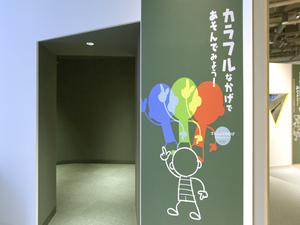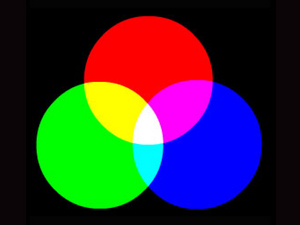Nagoya City Science Museum
TOP > Exhibition Guide > Keyword Search > Starting with "S" > shadow > Tricolored Shadows
Tricolored Shadows



Purpose of Exhibition
This exhibition is intended to give you understanding of the three primary colors while having fun by using three-colored illuminations in red, green and blue.
Additional Knowledge
[Three Primary Colors of Light]
Among others, lights of the three colors, red, green and blue, are called the "primary colors of light". It is because the combinations of these three colors enable you to produce all the colors.
Now, in this exhibition, lights of the three primary colors are set up. If you obstruct two of the lights, what happens to their shadows? For example, if you obstruct the lights of red and blue, the shadow from the rest of the lights can be seen as green, because only the green light can be received Then, if you obstruct only one light, what color shadow is the light seen as? If you obstruct the red light, cyan shades mixed with green and blue light is produced. If you obstruct the green light, mixed magenta is produced. If you obstruct the blue light, yellow shadow is produced. The relationship between the light colors obstructed and the shadow colors produced is called "complementary color".
[Why Can All Colors be Obtained by the Three Primary Colors?]
Why can all colors be represented in the three primary colors?The human retina has three types of light_sensitive receptors. Each is sensitive to red, green, and blue light. According to the different intensity perceived by the three different receptors, we are aware of various colors.
When the three receptors feel light intensity equally, it becomes all white.
Looking at the expansion of displays such as television, personal computers and mobile phones, you can see that each portion of the screen is made by colors points (pixels) of the three primary colors. For each primary color pixel, a 256 degree of lightness display, namely 256 degree multiplied by 256 (16,777,216 colors in total) can be represented.
[What about Printers and Paintings?]
In the case of prints and paintings, colors may be expressed with ink or paint and paper, and light conditions are different. Light gets brighter by color mixing, Ink get darker when mixed. With printers, when mixing yellow (Y), magenta (M) and cyan (c), three primary colors, various colors are obtained. To make the light reflected from the paper, we can say that each complementary color of each primary color light has become primary colors of ink. In theory, CMY is supposed to be three colors of black, but it is difficult to make a real full black, so to adjust the darkness of the black, (K) ink is used. When expanding the color printing of newspaper, it reveals that it does actually consist of those 4 colors.
Article by Shoji Nishimoto, curator
